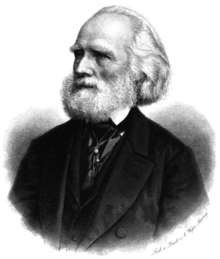Alexander Braun
| Alexander Braun | |
|---|---|

Alexander Braun
|
|
| Born | 10 May 1805 Regensburg |
| Died | 29 March 1877 (aged 71) |
| Fields | botany |
| Institutions |
Freiburg Giessen University of Berlin |
| Known for | morphology |
Alexander Carl Heinrich Braun (10 May 1805 – 29 March 1877) was a German botanist from Regensburg, Bavaria. His research centered on the morphology of plants.
He studied botany in Heidelberg, Paris and Munich. In 1833 he began teaching botany at the Polytechnic School of Karlsruhe, staying there until 1846. Afterwards he was a professor of botany in Freiburg (from 1846), Giessen (from 1850) and at the University of Berlin (1851), where he remained until 1877. While in Berlin, he was also director of the botanical garden. In 1852, he was elected a foreign member of the Royal Swedish Academy of Sciences.
Braun is largely known for his research involving plant morphology. He was a proponent of vitalism, a popular 19th century speculative theory that claimed that a regulative force existed within living matter in order to maintain functionality. Despite these beliefs, Braun made important contributions in the field of cell theory.
From his 1830s analysis of the arrangement of scales on a pine cone he was a pioneer of phyllotaxis.
In 1877 Wilhelm Philippe Schimper and Philipp Bruch named the plant genus Braunia in his honor. Also, a decorative plant known as "Braun's holly fern" (Polystichum braunii) commemorates his name.
...
Wikipedia
